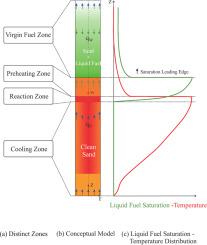Fuel mobility dynamics and their influence on applied smouldering systems
IF 5.8
2区 工程技术
Q2 ENERGY & FUELS
引用次数: 0
Abstract
Many recent environmentally beneficial applications of smouldering treat hazardous organic liquid fuels in inert porous media. In these applications, organic liquid mobilization can affect the treatment process, and the dynamics are poorly understood. Organic liquid mobilization is therefore a key knowledge gap that hinders the optimization of applied smouldering. This is especially the case in large scales where mobilization appears to be more significant. Liquid mobilization inside a porous medium cannot be easily measured directly, therefore numerical modelling is essential to understand the fundamental processes and to clarify the effects and dynamics of the fuel mobilization on the smouldering reaction. Contrasting numerical models with experimental temperature measurements have revealed many aspects of smouldering that cannot be measured. In this study, a previously developed 1D smouldering model was equipped with multiphase flow equations and compared against laboratory column experiments. The combination of model and experiments has served to quantify the dynamics of organic liquid fuel mobility by simulating high (i.e., non-mobile) and low (i.e., mobile) viscous fuels. The findings from this study shed light on the complicated interplay between multiphase flow, heat and mass transfer, and smoulder chemistry common to many applied smouldering systems. Numerical results confirmed that increasing the viscosity results in fuel remaining in the reaction zone and led to an increase in the peak temperature and smouldering front velocities. Lower viscosity fuels mobilized away from the reaction zone, thereby accumulating fuel in the pre-heating zone of the reactor. The fundamental understanding generated from this research will improve the design, implementation, and optimization of smouldering-based technologies for environmentally beneficial applications worldwide.

燃料流动动力学及其对应用烟熏系统的影响
最近许多有益于环境的烟熏应用都是在惰性多孔介质中处理有害的有机液体燃料。在这些应用中,有机液体移动会影响处理过程,而人们对其动态变化知之甚少。因此,有机液体迁移是一个关键的知识缺口,阻碍了烟化应用的优化。特别是在大规模应用中,这种情况更为明显。多孔介质内部的液体移动不容易直接测量,因此,要了解基本过程并阐明燃料移动对烟化反应的影响和动态,必须进行数值模拟。数字模型与实验温度测量结果的对比揭示了烟熏的许多无法测量的方面。在本研究中,先前开发的一维烟化模型配备了多相流方程,并与实验室柱状实验进行了比较。模型和实验相结合,通过模拟高粘度(即非流动性)和低粘度(即流动性)燃料,量化了有机液体燃料的流动动态。这项研究的结果揭示了多相流、传热和传质以及许多应用烟熏系统常见的烟熏化学之间复杂的相互作用。数值结果证实,增加粘度会使燃料停留在反应区,并导致峰值温度和烟熏前沿速度上升。粘度较低的燃料会远离反应区,从而在反应器的预热区积聚燃料。这项研究产生的基本认识将改进基于烟化技术的设计、实施和优化,使其在全球范围内得到有益于环境的应用。
本文章由计算机程序翻译,如有差异,请以英文原文为准。
求助全文
约1分钟内获得全文
求助全文
来源期刊

Combustion and Flame
工程技术-工程:化工
CiteScore
9.50
自引率
20.50%
发文量
631
审稿时长
3.8 months
期刊介绍:
The mission of the journal is to publish high quality work from experimental, theoretical, and computational investigations on the fundamentals of combustion phenomena and closely allied matters. While submissions in all pertinent areas are welcomed, past and recent focus of the journal has been on:
Development and validation of reaction kinetics, reduction of reaction mechanisms and modeling of combustion systems, including:
Conventional, alternative and surrogate fuels;
Pollutants;
Particulate and aerosol formation and abatement;
Heterogeneous processes.
Experimental, theoretical, and computational studies of laminar and turbulent combustion phenomena, including:
Premixed and non-premixed flames;
Ignition and extinction phenomena;
Flame propagation;
Flame structure;
Instabilities and swirl;
Flame spread;
Multi-phase reactants.
Advances in diagnostic and computational methods in combustion, including:
Measurement and simulation of scalar and vector properties;
Novel techniques;
State-of-the art applications.
Fundamental investigations of combustion technologies and systems, including:
Internal combustion engines;
Gas turbines;
Small- and large-scale stationary combustion and power generation;
Catalytic combustion;
Combustion synthesis;
Combustion under extreme conditions;
New concepts.
 求助内容:
求助内容: 应助结果提醒方式:
应助结果提醒方式:


